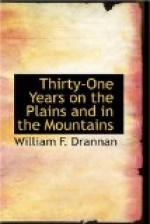The next day, when Uncle Kit and Mr. Hughes assured me that it was really dog meat, we had eaten the night before, I felt very much like throwing up everything I had eaten at the village, but it was too late then.
After supper, that night in the Indian village, we had what was called a “peace smoke.” The Chief selected about a dozen of his braves, and all being seated in a circle, two of our party on one side of the Chief, and Uncle Kit at his right, a pipe was lit and the Chief took one whiff, the smoke of which he blew up into the air. He then took another whiff, and turning to his chief guest, handed him the pipe, who blew a whiff into the air and the second one into the face of the host. This performance having been gone through with for each guest, the Chief then handed the pipe to the first Indian on his right, and thus it went around the circle, each Indian blowing a whiff into the air.
It was considered a great breach of etiquette to speak, or even smile, during this ceremony.
This Indian village was situated at Pawnee Rock, on the Arkansas river, in a beautiful valley, in what is now the southwest corner of Benton Co., Kan. The wick-i-ups were made of poles set on ends, gathered together at the top, and covered with buffalo skins from which the hair had been removed.
The Kiowas were, at that time, the most numerous tribe of Indians in the United States.
Early the next morning after our dog-feast and peace-smoke, our party was up and off, and I was particularly glad to get away, feeling that I would rather camp out and feed on buffalo, antelope, jack-rabbits and wild turkey than dwell in the lodges of Kiowas and be “honored” with banquets of the nicest dogs in all that region.
We took the Santa Fe trail and the buffalo were so numerous along the way that we had to take some pains to avoid them, as when they were traveling or on a stampede, nothing could turn or stop them and we would be in danger of being ground to atoms beneath their thousands of hoofs.
In two days more of travel we reached another Indian village, on another beautiful plain, in what is now Pawnee Co., Kan. Here the country was so level that one could see for miles in any direction, and the sun rising or setting, seemed to come up or go down, as a great golden disk, out of or into the earth. We could see many bands of wild horses feeding on the luxuriant grasses, and little did I think, then, that I would live to see the day when that broad and unfenced plain would be converted into homes for hundreds of the pale-faced race.
We were met on the outskirts of the village by White Horse, Chief of the Comanches, who, being an intimate friend of Uncle Kit, shook hands with us and conducted us to his own wick-i-up. There we unpacked the animals and piled up our goods, and White Horse detailed an Indian to guard the packs day and night.
After our horses had been picketed out to grass, the Chief took us into his lodge to dine with him, and here again we had boiled dog and the peace smoke.




